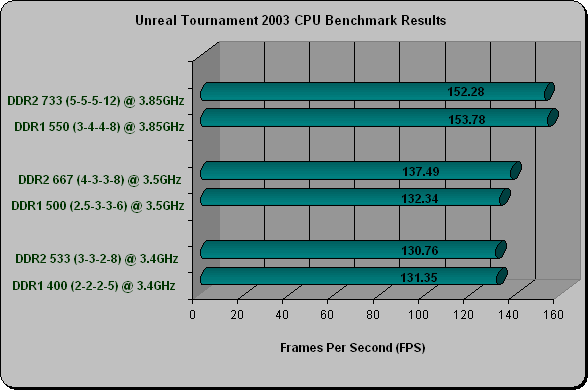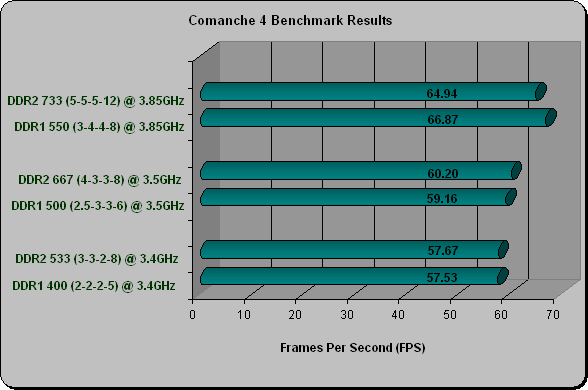Is DDR2 Ready To Replace DDR1???
Epic Games; Unreal Tournament 2003:
Even though this article is aimed at memory bandwidth I’d get burned at the stake by the gamers if I didn’t include some gaming benchmarks. For these benchmarks we are showing the lowest possible timings for the best performance!
Epic Games; Unreal Tournament 2003:
Using the full installation of Unreal Tournament 2003 along with the newest patch gives us a very nice real world benchmark! A resolution of 640×480 was tested in Direct3D on one of our custom benchmarks was also used to see if any differences could be observed.

Results: It really looks like a dead heat when looking at DDR1 400 versus DDR2 533, that changes when we reach the DDR2 667 versus DDR1 500 match! Here we were able to run our DDR2 memory at aggressive 4-3-3-8 timings and were able to pass up the DDR1 500 at 2.5-3-3-6 timings by five frames per second. DDR2 733 puts up a tough fight against DDR1 550, but the performance is hurt by having to run at CL5. We maxed out the memory voltages at 2.25 Vdimm, but couldn’t get anything lower than 5-5-5 at DDR2 733.
NovaLogic; Comanche 4:
The Comanche 4 benchmark demo is a unique benchmark as it represents a real-world gaming experience. It contains the single player Eagle’s Talon mission from the game as well as a detailed cinematic. This DirectX 8.1 benchmark demo measures your system’s performance in the standard frames per second format. We ran our benchmark at 640 x 480.

Results: It really looks like a dead heat when looking at DDR1 400 versus DDR2 533 and then DDR1 500 versus DDR2 667. There is actually no significant difference shown at any of these speed grades! Pretty much a mirror of the UT2003 results.
Conclusions:
Nathan Kirsch’s Thoughts:
All said and done we learned a lot from benchmarking for this article. First off we found that it was possible for DDR2 PC2-4200 4-4-4 memory to hit low latencies of 3-3-2 (3-2-2 is the lowest possible). Secondly we found out that memory rated for DDR533 by almost all brands overclocks VERY well. A prime example of this was our ability to get an extra 200MHz out of our DDR533 Crucial memory. When DDR1 memory first hit the market you didn’t see people overclocking memory 200MHz from the get go! So in terms of being a new product it looks as if DDR2 memory will scale nicely and quickly in the following months.
Overclockers & Enthusiasts will be happy to learn that DDR2 starts looking good above DDR667. To reach DDR667 or PC2-5300 one just has to set the FSB in the BIOS to 250MHz and leave the memory divider at 3:4 (same ratio for DDR2 533Mhz) and you are running at DDR667. As always the motherboard you are using makes a world of difference and so far we have seen the best memory performance out of the ABIT AA8-DuraMax with BIOS version 13. With our ABIT AA8-DuraMax and Crucial PC2-4200 memory we have been able run 275MHz FSB with minimal tinkering to the BIOS. Yes, this was on both retail and engineering samples. The overclocking lock that Intel has put into their chipset has clearly been gone around by ABIT and other manufacturers via BIOS tweaks. This was evident by us hitting 275MHz FSB on our platforms, so just like PAT a year ago this lock has been gone around thanks to board makers.
To conclude this article we would like to point out that DDR2 667 memory has begun to hit the market! Just in the past week we have seen press releases that TwinMOS Technologies and Corsair Memory have officially announced PC2-5300 (DDR2-DDR667) memory to the consumer. Both of these PC2-5300 modules are rated at 4-4-4 timings, but with any luck they should be able to run at the 4-3-3 timings at DDR667 that we got out of our Crucial PC2-4200 memory when run at DDR667. We haven’t had a chance to take a look at either of these, but now enthusiasts have more options for their DDR2 systems
Legit Bottom Line: Expect DDR2 memory at 533MHz to be comparable to DDR1 at 400MHz, but don’t expect to see any “noticeable” memory bandwidth performance gains till DDR2 667 and above with low timings!

Comments are closed.